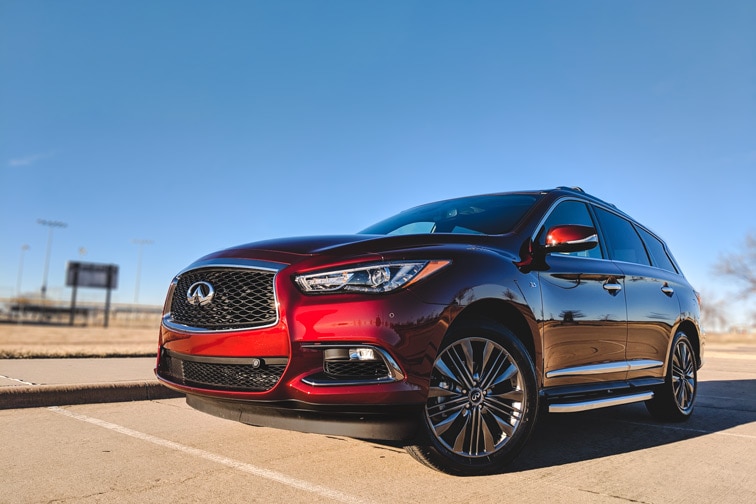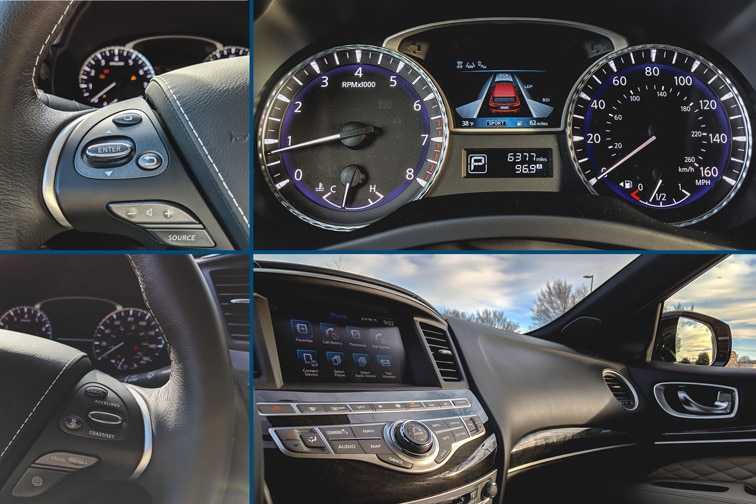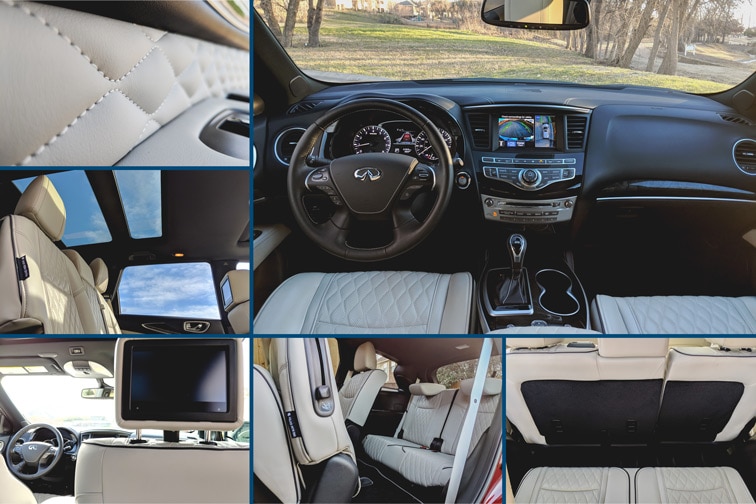2019 Infiniti QX60 Review: Practical Luxury
A Luxe Veneer, Draped Over Three Rows of Practicality
 Aaron Miller/Capital One
Aaron Miller/Capital One
The 2019 Infiniti QX60 is arguably the company’s most important vehicle. That’s partly because it features three rows of seats, a smooth ride and, if you opt for the higher “Luxe” trim level, more technological trappings than you can play with on your way to work.
Save for a trio of new colors (including Deep Bordeaux, shown) and a few tweaks to trim packages, the QX60 remains largely unchanged since its last major refresh a few years ago. While, fundamentally, it’s the same vehicle that first debuted in 2013, age hasn’t slowed QX60 sales one bit. Last year, it surpassed the Q50 sedan as Infiniti’s best-selling vehicle—further proof that the practicality of crossovers is causing the sun to set on sedans.
What is it about the QX60 that piques the interest of more and more buyers? That’s what we set out to learn when Infiniti dropped one off for us to drive. Surprisingly, the answer is somewhat philosophical.
 Aaron Miller
Aaron Miller
In the QX60, luxury is experiential
Infiniti relies on visual and aural cues to continually remind you that you’re in a premium vehicle. In this sense, it’s more experiential than tactile. The Bose Cabin Surround sound system uses 15 speakers to deliver one of the best symphonic accompaniments south of the six-figure price range. The available quilted leather is patterned to give a visual impression that it’s softer and more supple than it really is—and in so doing, give it a more upscale look.
There’s also technology almost everywhere your eyes can land. That includes a full suite of advanced driver aids—clearly displayed in the instrument panel—not to mention the 56 switches, buttons and knobs on located on the center console and steering wheel. It may seem like sensory overload at first, but all those buttons make nearly everything easy to use. The result, which is often overlooked as a luxury in its own right, is less stress when trying to adjust something.
You May Also Like:
More Crossover Reviews
Leasing vs. Buying a Car: A Flow Chart
How to Keep Your Car Looking Like New Without Ever Waxing It
 Aaron Miller
Aaron Miller
There’s more than meets the eye in the design
The QX60 can appear either boldly flowing or crisply modern, depending on whether you approach it from the front or rear.
Deep, sharp lines on the hood integrate Infiniti’s trademark grille and lend a bulging, flare-like appearance to otherwise benign fenders. The flowing design quickly transforms into clean, angular creases that compliment where light naturally falls, making the QX60 look longer and more sleek.
The rear bumper, LED taillights and spoiler at the back of the roofline all jut out to denote a clear endpoint for a vehicle that evolves more than most from front to rear.
 Aaron Miller
Aaron Miller
Inside, function is disguised as form
The QX60 comes with a wide array of option packages—mostly available only on the Luxe trim level—that add a ton of flashy tech and tactile touches. The Sensory Package (MSRP $3,500), for example, gets you the aforementioned Bose sound system, but also heated and ventilated seats, heated second row seats, and power third row seatbacks that return to their locked and upright position at the touch of a button.
The Theater Package (MSRP $2,150) nets 8-in monitors built into the headrests, and the Essential Package (MSRP $2,900) rounds off tech needs with Infiniti’s “around view” monitor. Image quality is above-average image quality and controls are intuitive, so you have no excuses if you park too closely to the car next to you.
The QX60’s biggest selling point, though, is likely a real-world functionality of the third row. More specifically, the second row is designed so that, even with a child seat in place, accessing the third row doesn’t require advanced gymnastic aptitude. Once in there, the available rear seat moonroof helps prevent the feelings of claustrophobia that are so often par for the course in the back of a midsize three-row crossover.
 Aaron Miller
Aaron Miller
Insulation from your daily commute
In terms of performance, the QX60’s 295 hp, 3.5L V6 is competitive, and the continuously variable transmission (CVT) does a fine job of ensuring you always have enough power when you need it. Fuel economy isn’t the worst in its class, but at an EPA-estimated 22 mpg combined, it’s not the best, either.
More than a few of the Infiniti’s midsize three-row SUV competitors amble through curves with agility reminiscent of a school bus, but not the QX60. Turn the steering wheel, and the whole vehicle settles down and reassuringly handles anything it’s asked to do. Within the laws of physics, of course.
If the QX60’s engineers intended to insulate drivers from the harshness of a morning commute, they succeeded. In a straight line, though, the QX60 tends to bounce and float over routine bumps and dips as the suspension works to prevent any kind of jolt—a task at which it’s largely adept. Behind the wheel, the QX60’s most obvious trait is a feeling of being disconnected from the road. If, like most people, you don’t generally contemplate how your current ride feels through your fingertips, then that’s a good thing. If, on the other hand, you’re looking for something more akin to a sports sedan in a three-row crossover’s clothing, there are other options.
A cleverly-hidden safety net
The QX60’s standard automatic emergency braking system can detect wayward pedestrians while traveling at speeds of up to 37 mph. That might not sound all that fast, but it’s quite high if you’re on a residential road, where unattended small children are both more likely and less predictable. For a more comprehensive suite of advanced safety features, the available ProACTIVE Package (MSRP $3,400) can nudge an inattentive driver back into the lane. It also features Intelligent Cruise Control, automatically keeps up with light traffic by braking and accelerating to match the vehicle in front of you. It can even apply up to 40% of the braking force to come to a complete stop if needed, but it’s not a substitute for actually driving.
When it comes to safety, form should always follow function, and some carmakers have struggled mightily when it comes to gracefully implementing the cameras and sensors required by modern safety systems like these. That’s not the case here, though, with only a discreet radar array tucked into the bottom of the front bumper and a camera on the windshield by the rearview mirror. While not invisible, it’s far less conspicuous than some of the other solutions on the market.
Conclusion: a luxe veneer draped over three rows of practicality
On paper, the QX60 includes a comparable set of features and dimensions to a fully-loaded Toyota Highlander. The differentiator lies in the intangibles: the utility-oriented Highlander doesn’t exude the kind of emphasis on design that sways buyers to more premium brands like Infiniti in the first place. The similarly-sized Audi Q7, meanwhile, does offer that emphasis, along with a greater focus on the subjective elements of the driving experience. The trade-off is practicality: the QX60 offers more legroom in all three rows and holds a sizeable advantage in cargo area.
The Infiniti QX60, then, is Infiniti’s new sales king because it sits in a sweet spot of compromise. Strip away all the bells, whistles and design elements, and it’s still as practical as any as any midsize crossover, regardless of price. That practicality, wrapped in a layer of visual, aural and technological luxury, makes it a strong value for an ever-increasing number of buyers.
Written by humans.
Edited by humans.
 Aaron Miller
Aaron MillerAs a veteran automotive journalist, I have been fortunate enough to drive some of the most desirable cars on the planet and get to know some of the most important people in the industry. Before joining Capital One, I served as the Cars Editor for a major national website, and covered industry news and analysis for well-known automotive-specific sites. I also wrote feature articles and reviews for niche enthusiast websites. I’ve been obsessed with cars since—literally—before I can remember, with my collection of die-cast and slot cars taking center stage during my formative years. Simply put, for me, working isn’t really “work.”
Related articles
View more related articles